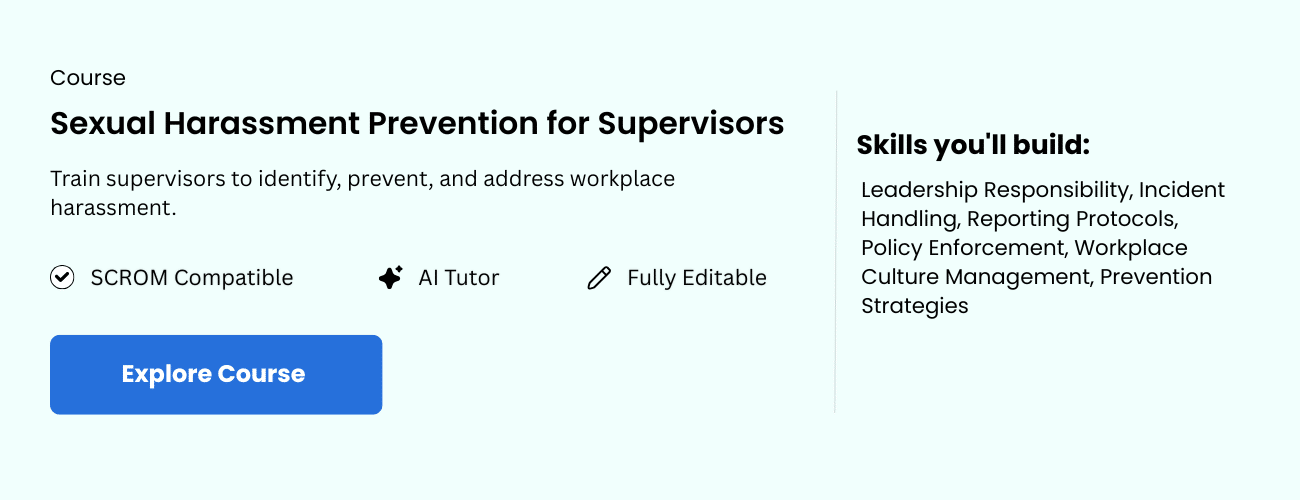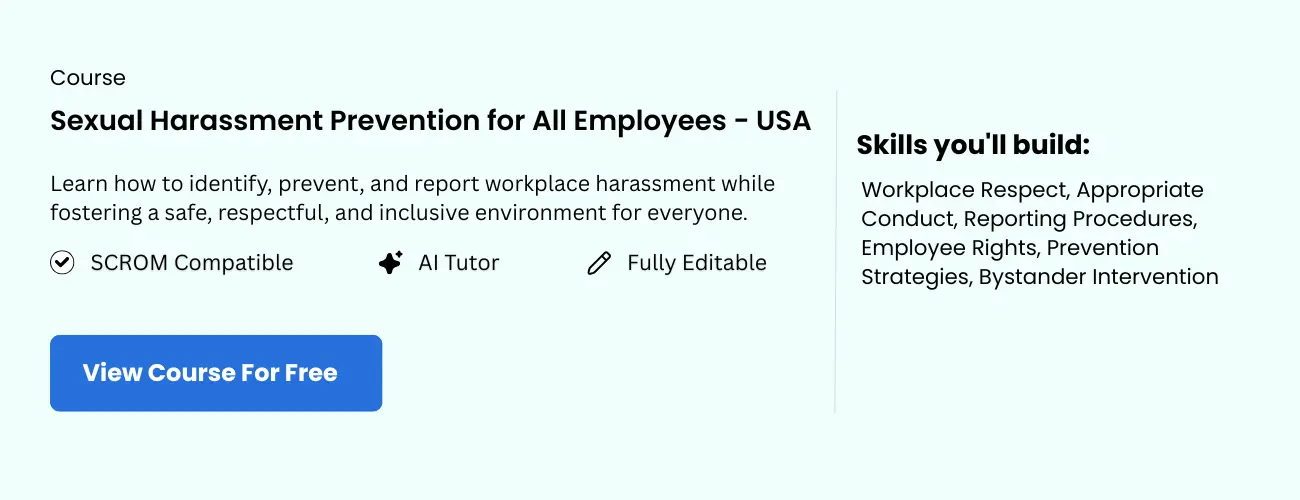Introduction
Sexual harassment continues to be a significant concern across workplaces, educational institutions, and public spaces throughout Chicago. Recent legal reforms and increased awareness have underscored the importance of comprehensive sexual harassment training to foster safe, respectful environments.
This article provides an in-depth overview of these programs, emphasizing their purpose, scope, and the vital role they play in promoting awareness and accountability. Whether you’re an employer, employee, educator, or student, understanding the essentials of sexual harassment training is crucial for preventing misconduct, ensuring legal compliance, and cultivating a positive, inclusive culture.
Chicago’s focus on Sexual Harassment Prevention for All Employees highlights the need for universal participation, ensuring every individual understands their rights, responsibilities, and the behaviors that constitute harassment. By equipping all employees with the proper knowledge, organizations can strengthen reporting culture, reduce incidents, and build workplaces where respect is the foundation.
Through exploring core elements and benefits, this guide aims to be a valuable resource for navigating Chicago’s legal landscape and reinforcing commitments to respectful interactions.
Understanding Chicago’s Sexual Harassment Training Laws
Navigating Chicago’s legal requirements for sexual harassment training is vital for employers and employees committed to fostering respectful workplaces and ensuring legal compliance. This chapter offers a comprehensive overview of the applicable city ordinances, Illinois state laws, and key legal definitions.
Legal Framework Overview
Chicago’s approach draws from a combination of city ordinances, Illinois state statutes, and federal regulations. These laws collectively mandate that employers implement effective harassment prevention training aimed at educating employees and reducing misconduct.
Chicago City Ordinances
The City of Chicago has enacted specific ordinances targeting workplace harassment. The Chicago Human Rights Ordinance (CHRO) prohibits employment discrimination based on sex, including protections against sexual harassment. Although not explicitly mandating training, the city encourages preventative measures, and recent amendments highlight employer responsibilities in creating safe work environments.
Illinois State Regulations
Illinois leads with comprehensive laws requiring employers with 15 or more employees to provide sexual harassment prevention training annually. The Illinois Human Rights Act (IHRA) is overseen by the Illinois Department of Human Rights (IDHR) and sets guidelines for effective, consistent training modules that align with state standards.
Eligible Employers and Employees
Coverage applies to private businesses, nonprofits, government agencies, and other entities employing at least 15 individuals. All employees full-time, part-time, seasonal are protected under these laws, emphasizing the importance of inclusive training regardless of position or tenure.
Key Legal Definitions
- Sexual Harassment: Unwelcome sexual advances, requests for favors, or other conduct of a sexual nature that adversely affects employment or creates an intimidating work environment.
- Hostile Work Environment: A workplace where conduct related to sex unreasonably interferes with work and fosters discomfort or intimidation.
- Quid Pro Quo Harassment: Employment decisions made based on submission to or rejection of sexual advances.
Understanding these definitions is crucial for compliance and effective prevention efforts.
Mandatory Requirements for Chicago Sexual Harassment Training
Meeting Chicago’s training laws requires organizations to understand specific content, timing, delivery methods, and recordkeeping obligations. Complying with these mandates helps foster safe workplaces and minimizes legal risk.
Legal Foundations for Sexual Harassment Training
The Chicago Human Rights Ordinance (Chapter 18-8-0900) mandates that employers provide proper training to prevent harassment. These requirements align with state and federal protections, emphasizing proactive prevention and accountability.
Content Requirements: What Must the Training Cover?
Training programs must address key topics such as:
- Definitions and examples of sexual harassment
- Employees’ rights under city, state, and federal laws
- Employer obligations to prevent and address harassment
- Reporting procedures and confidentiality
- Strategies for fostering respectful workplaces and bystander intervention
These modules should be current, accessible, and understandable for all employees.
Duration and Frequency of Training
Initial training must last at least 1 hour, covering essentials for both employees and supervisors. For new hires, training should be completed within 90 days. Refresher sessions are mandated annually, and newly promoted supervisors must undergo training within 90 days of promotion. Regular schedules help sustain awareness and compliance.
Delivery Methods
Training can be conducted through in-person workshops, online modules, webinars, or hybrid approaches. Engaging, interactive sessions—such as role-playing or scenario analysis—are strongly encouraged to enhance understanding and retention.
Recordkeeping Obligations
Employers must retain detailed records of every training session for at least three years. Documentation should include dates, attendance, training materials, trainer credentials, and proof of completion. These records are essential for inspections and audits to demonstrate ongoing compliance.

Best Practices for Effective Sexual Harassment Prevention
Developing Impactful Training Programs
Successful prevention starts with well-designed training that clearly explains what constitutes harassment, its impact, and respectful behaviors. Interactive, scenario-based training tailored to organizational contexts boosts engagement. Including real-life examples helps employees identify inappropriate conduct and understand reporting processes, fostering a proactive culture.
Fostering an Inclusive Workplace Culture
An inclusive environment reduces harassment risks. Leadership must model appropriate behaviors and set clear expectations. Policies promoting diversity, respect, and zero tolerance reinforce organizational standards. Regular team activities and open dialogue strengthen relationships and empower employees to report concerns without fear of retaliation.
Handling Complaints Effectively
Trustworthy, transparent procedures for addressing harassment complaints are essential. Organizations should establish clear reporting channels, ensure confidentiality, and conduct prompt, fair investigations. Training managers and HR professionals in sensitive handling and investigative techniques enhances resolution effectiveness and employee confidence.
Maintaining Ongoing Education and Monitoring
Prevention requires continuous effort. Regular refresher courses, legal updates, and awareness campaigns keep harassment prevention front and center. Organizations should analyze incident data, gather feedback, and adjust policies accordingly. Staying informed about societal changes and legal updates ensures sustained, effective prevention efforts.
Staying Compliant and the Consequences of Non-Compliance
Strategies for Maintaining Compliance
Proactive compliance management involves clear policies, ongoing training, and regular audits. Developing detailed policies aligned with federal, state, and local laws sets a strong foundation. Internal checks and the use of compliance software can help track training, monitor progress, and identify gaps before violations occur.
Legal and Financial Penalties for Violations
Violations can lead to legal action, hefty fines, and reputational damage. Fines under laws like the Fair Pay and Safe Workplaces can reach hundreds of thousands of dollars per incident. OSHA penalties may run into six figures for serious violations, along with legal costs, settlements, and remediation expenses. Data privacy breaches can incur significant penalties from agencies like the FTC.
Resources for Staying Informed and Compliant
Keeping up with the latest standards necessitates consulting trusted sources like OSHA, the Department of Labor, and industry associations. Regularly subscribing to updates, participating in seminars, and consulting with compliance professionals enhances organizational readiness. Engaging with legal and industry networks ensures timely adoption of new requirements.
Conclusion
Maintaining comprehensive employee training compliance in Chicago is key to establishing a safe, productive, and legally compliant workplace. Regular updates, meticulous record-keeping, and tailored training modules are critical components. Organizations should conduct periodic audits, utilize reputable training resources, and leverage technology to track progress.
Engaging with local resources like the Illinois Department of Labor or industry-specific experts can help stay current on evolving regulations. Investing in high-quality, ongoing training not only mitigates legal risks but also boosts employee engagement and safety. Proactive, informed approaches lay the groundwork for a resilient and compliant organization in Chicago.













